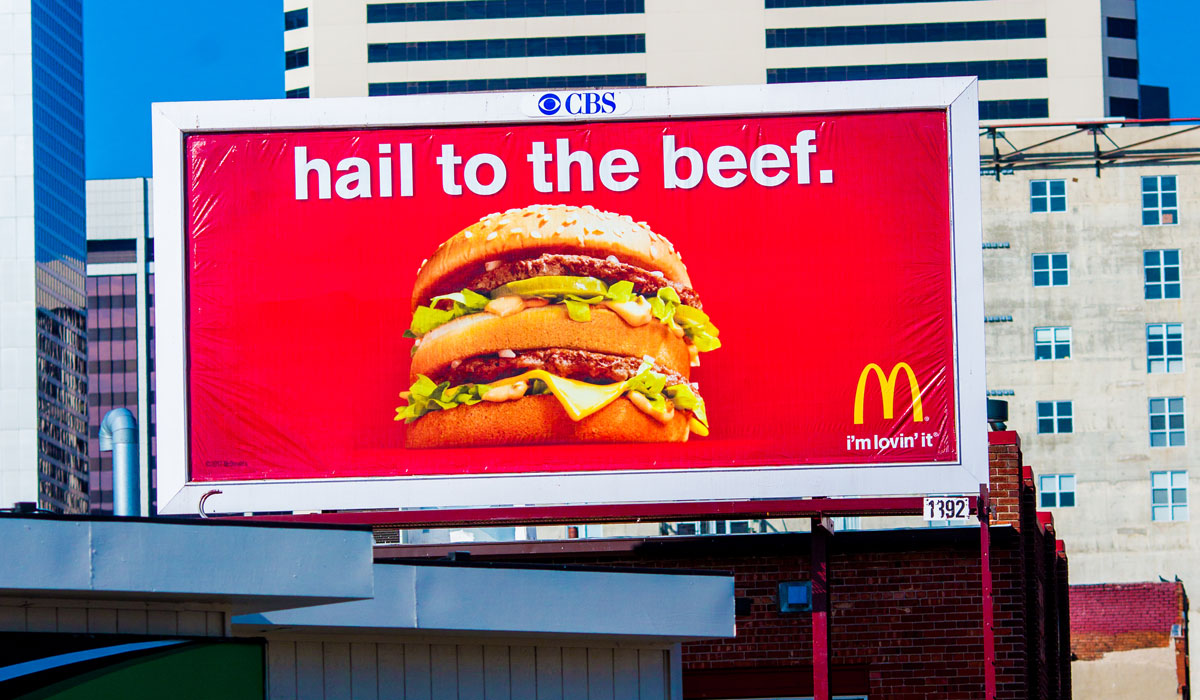In today’s world of social media and digital ads, traditional billboards almost seem archaic. Yet, the billboard industry is actually growing, largely because of its convergence with newer technologies. Billboards and other out-of-home (OOH) formats for quick-service restaurants can be seen everywhere. They’re still being bought because they’re still very effective marketing tools. Why is OOH still a savory choice for quick-serves?
DRIVE LOCAL TRAFFIC
Billboards on highways and expressways let drivers know where they can fill up on tasty food items in close proximity. They can drive foot traffic in more urban areas too. Most people don’t decide where they’re going to eat until just before they do. This is why billboards and other OOH formats are great for reaching people when they’re out and deciding where to eat. TV ads have been shown to make people more prone to eat. Imagine the power of a 48-foot billboard! This is why McDonald’s is always at the top of the list of companies spending the most on OOH.
DRIVE MOBILE TRAFFIC
Billboards aren’t just for driving traffic to physical restaurant locations, they can also be used to drive people to mobile apps. Many quick-service chains now have apps which allow mobile ordering and delivery. Mobile ordering cuts down on customer frustration by reducing wait times. It also tends to increase order size. While customers may be shy when supersizing their meal in person, this is less true when it’s done through an app. Driving more customers to use the mobile app means happier customers and larger orders.
GEOFENCING & LOCATION DATA
Whether the goal is to drive literal or mobile traffic, OOH and location data are working together to ensure the best possible results. Many billboards are now equipped with geofences which allow mobile retargeting. Geofences are invisible geographic fences placed around a billboard or other OOH format. Once they pass through the geofence, consumers will see ads on their device based on what geofence they were in. Imagine a customer seeing a billboard for McDonald’s. When they check a random app on their phone they’re later offered a coupon for McDonald’s. Since they’ve already been exposed to the billboard, they are more likely to click to engage with the coupon, and ultimately go to McDonald’s. In fact, people who see an OOH campaign are 17% more likely to engage with the brand on their mobile phone. This makes OOH and mobile a very powerful combination.
DEMOGRAPHICS & ATTRIBUTION
Aside from reaching consumers in a more contextually relevant manner, mobile integration also offers yet another benefit: obtaining demographic and attribution data. In addition to tracking general location, mobile analytics also allows marketers to see advanced anonymized demographic data. Using this data, advertisers could track purchasing and eating habits and know if a specific crowd is more likely to eat at Burger King or Chick-fil-A, for example. They could track browsing history and find similar interests of the exact audience that will be viewing their ad at lunch time. A mobile partnership could allow advertisers to extend their geotargeting efforts beyond traditional location-based formats. It enables them to place hyper-relevant content on virtually any type of display.
STAY IN BUDGET
When considering advertising, cost is one of the most important deciding factors for quick-serves. Small and local chains don’t have as much to spend on advertising as the national chains. Not everyone can saturate the market like the big guys, but billboards can be made to fit almost any advertising budget. While it varies depending on which market the billboard will be placed, they are surprisingly affordable. In general, they’re much cheaper than newspaper, magazine, and television ads. Outdoor ads deliver the best value—in terms of cost-per-thousand impressions—of any type of advertising, even digital.
OOH WORKS
OOH works. It’s big, it’s loud, and if the design is clever, it’s extremely memorable. Just how impactful? According to the OAAA, of those who have seen an outdoor ad:
- 41 percent are more likely to learn about the brand being advertised
- 70 percent say outdoor ads are very, or somewhat likely, to influence a purchase
- 58 percent search the web as a direct result of seeing an ad
- 55 percent use mobile and social media to share information while viewing an outdoor ad
- 35 percent buy a product after seeing an ad
PEOPLE LIKE OOH
While all kinds of ad formats can be effective, consumers have gotten good at fast-forwarding or blocking most of them. On top of that, many people find digital ads frustrating. Billboards stand out, but they are also considered to be one of the least annoying ad formats today. 85 percent of all consumers believe OOH is useful, with 83% believing it is informative. Why use an ad format that is known to infuriate customers?
Cody J. Riebe is a Public Relations and Content Specialist for BillboardsIn.com, the largest online marketplace for outdoor ads. With over a million assets nationwide, they make it possible for anyone and everyone to easily buy billboards online.






